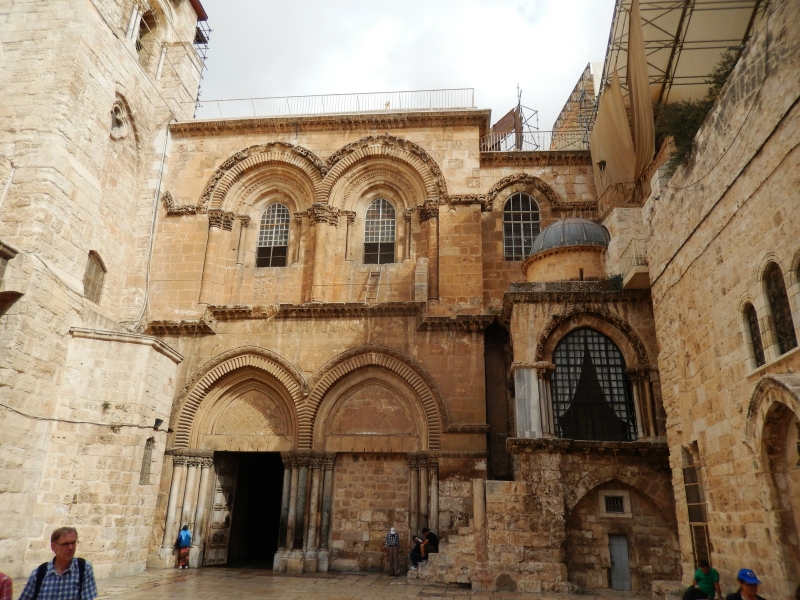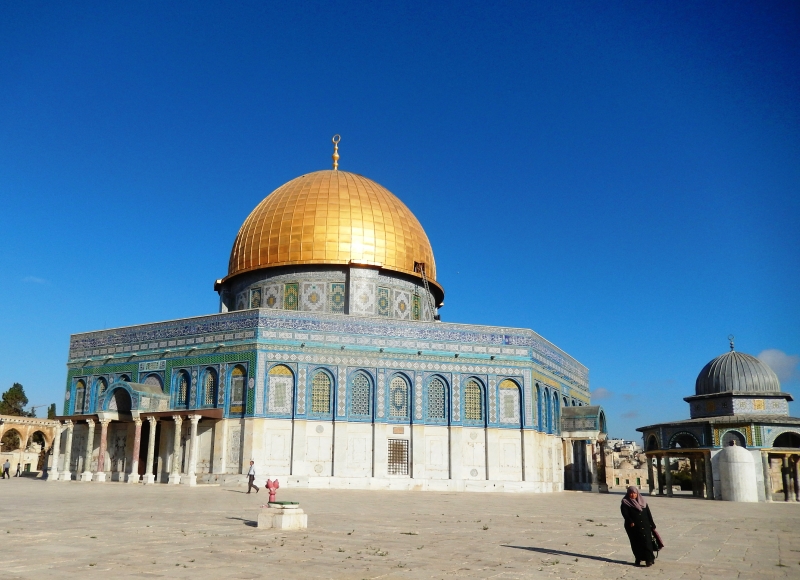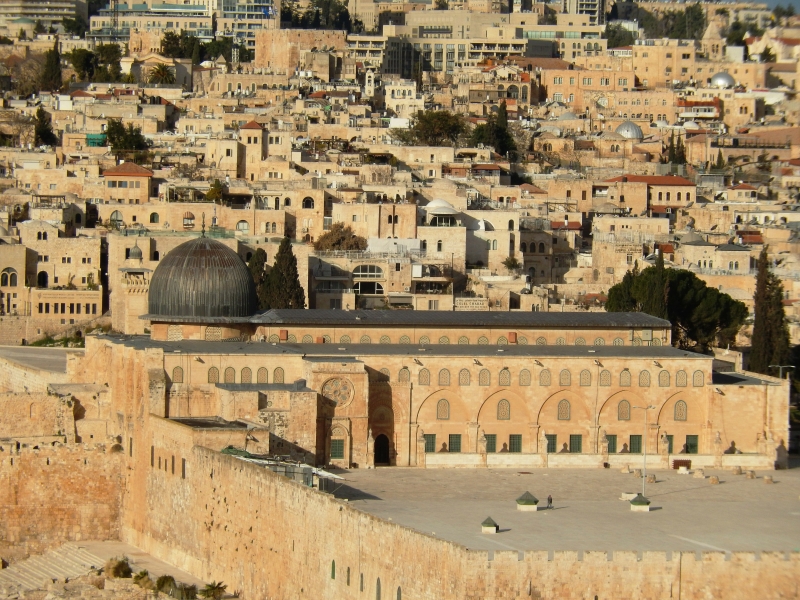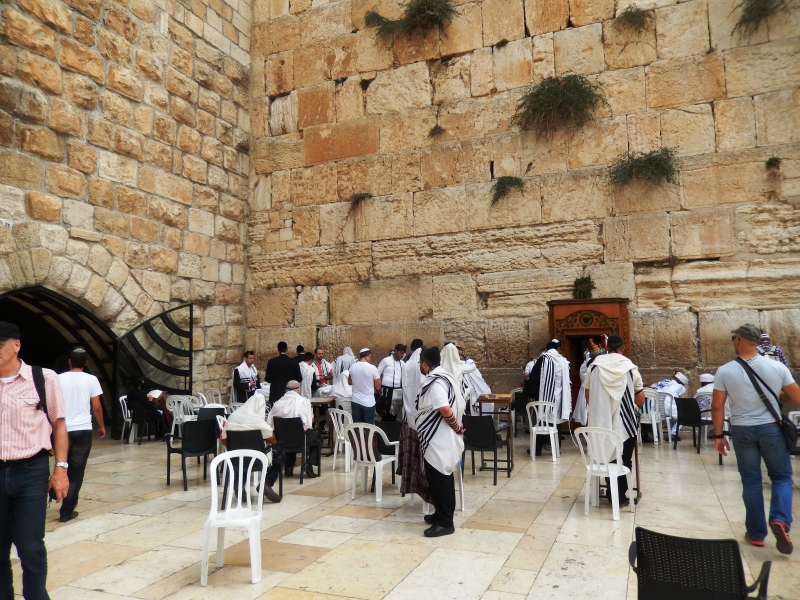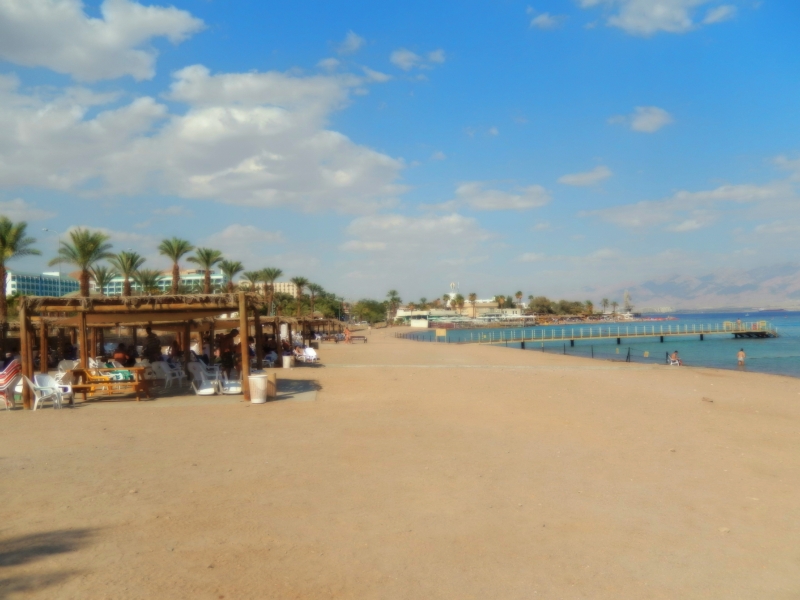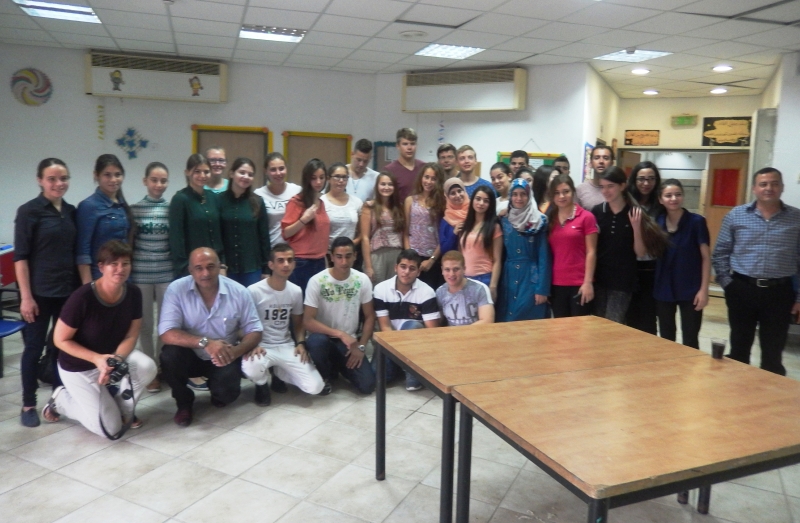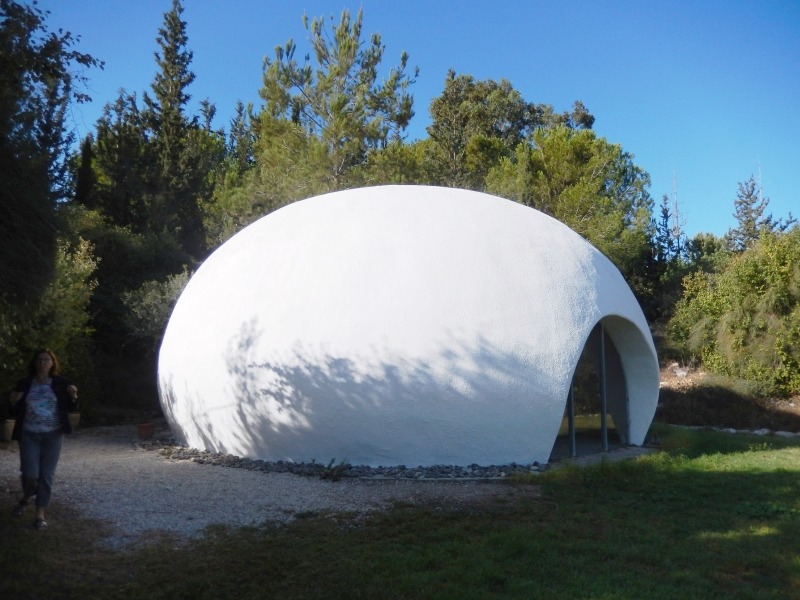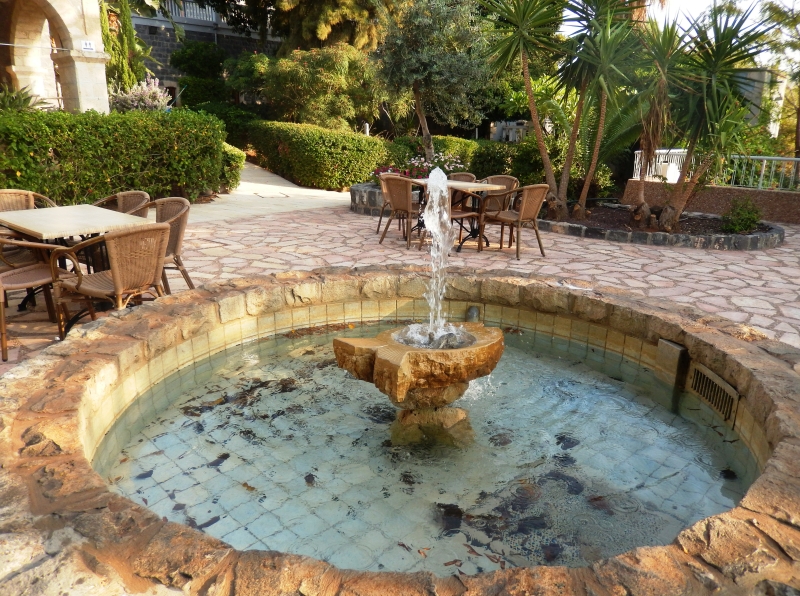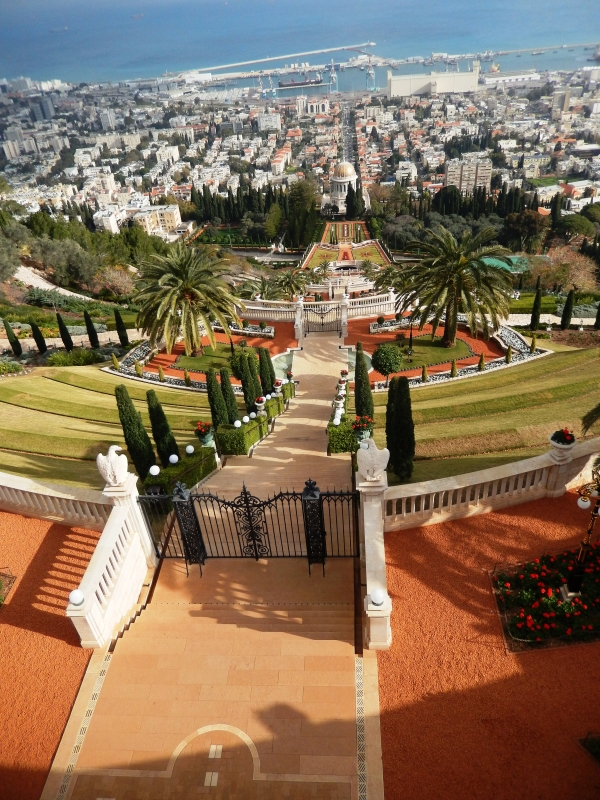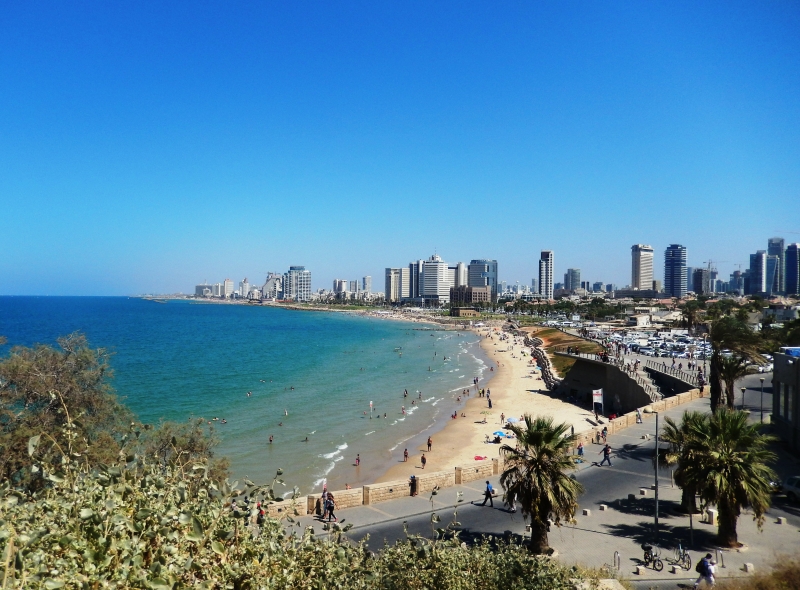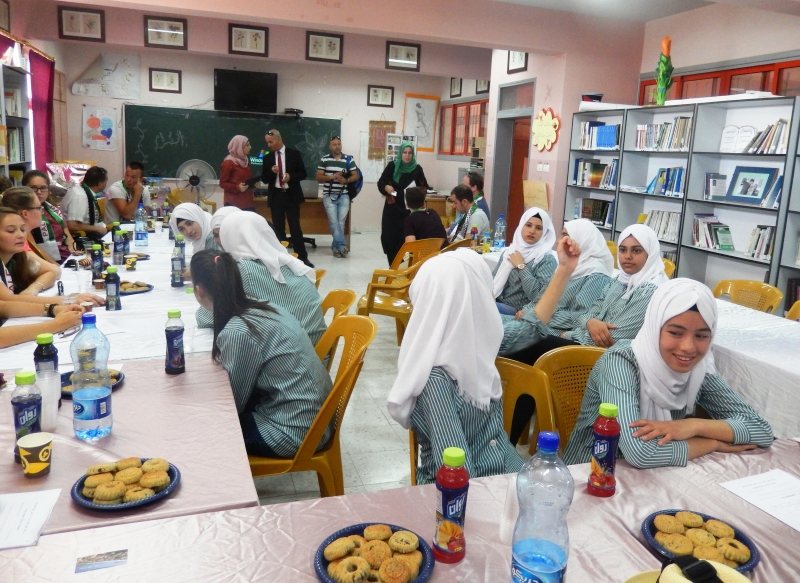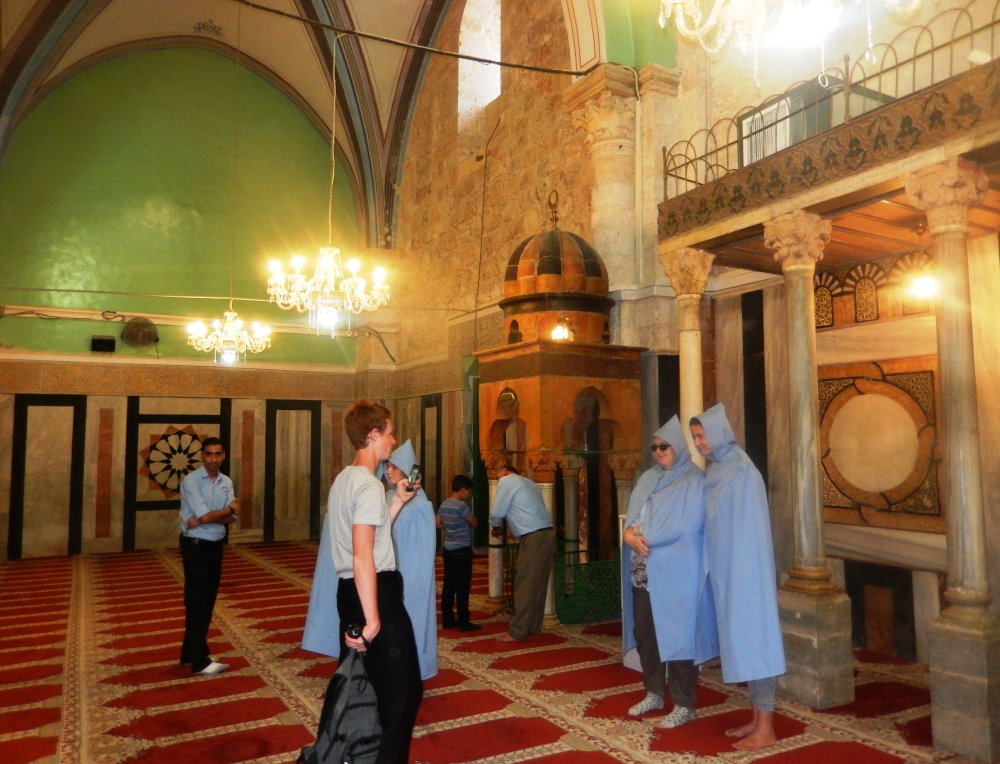Review Israel trip 2016
The trip to Israel-Palestine-Jordan | 07. – 23.10. 2016
This trip surpassed all previous trips in terms of experience value, as for the first time an additional 3 days of Jordan were planned. To give an impression of the programmatic diversity of our JIK trips, here are the most important impressions and stops from this unforgettable trip with background information and personal comments.
Right at the beginning of our trip – namely during our stopover in Munich – one participant suffered a breakdown due to fear of flying and therefore unfortunately had to abort the trip. This was of course a shock for all of us. This is particularly tragic since she had to cancel a trip to Israel-Palestine a few years earlier due to fear of flying. Therefore, all she has left are the pictures from the trip and the hope that one day she will be able to overcome her fear of flying after all.
Arrival in Tel Aviv-Jaffa
After arriving at Tel Aviv airport, we first experienced a surprise, as our previous driver Husam had to accompany another group with a large bus and we therefore had to make do with George as our driver. At first some of us were disappointed, but George did a wonderful job and even went a little faster than Husam. Before 5, we drove to the 5,500-year-old city of Jaffa (the adjacent city of Tel Aviv is a 1909 reincorporation) with its charming old town setting. However, since we were there before sunrise, we first stayed in a restaurant until we could start sightseeing around 8 am. Afterwards we bathed at the 10 km long dreamlike sandy beach of Tel Aviv-Jaffa at over 30 degrees and recovered from the exhausting night flight.
In the afternoon we drove to the beautifully situated Latrun Monastery (visit of the monastery church not possible because of a mass) and to the neighboring Army Museum, where Israel proudly presents its weapons captured in many wars (of course also from Germany). After a few kilometers we reached the peace village Neve Shalom – the only settlement where Jews, Christians and Muslims live together peacefully (war and peace are very close in Israel.). In the House of Silence and Prayer, we first listened to several young people from the settlement who presented vocal performances with guitar accompaniment for those present. Then we meditated for several minutes in absolute silence.
In the evening we reached our quarters, the Birgittine Convent on the Mount of Olives in East Jerusalem, where we were again warmly welcomed by Sister Teresa, among others.
Jerusalem
Early in the morning, George (an Arab Greek Orthodox Christian from Nazareth with an Israeli passport who lives with his wife in Bethlehem) took us by minibus to Jerusalem’s Temple Mount. Since we were very early at the very strict entrance control for tourists, we got without waiting times to the Temple Mount, where Muslim morality guards with us again any not sufficiently covered body parts complained. However, thanks to our precautionary brought cloths/scarves, we were able to fix these problems very quickly.
On the Temple Mount, the third largest sanctuary for Muslims after Mecca and Medina, stands next to the Al Aqsa Mosque the Dome of the Rock, built by Muslims at the end of the 7th century. was built on the site of the second, Herodian temple of the Jews, destroyed by the Romans in 70 AD. Jews are allowed to visit this place, but not to pray there, so as not to disturb the Muslims in their 5 times daily prayers. The strict entry control is carried out by the Israeli military. The Temple Mount itself is administered by the Muslim-Jordanian Waqf Foundation, which uses its own military as a check. Extremists on both sides now accuse each other of trying to change this complicated status quo unilaterally in their favor, resulting in repeated violent clashes. Radical Jews not only in Israel have reportedly already raised several billion dollars to demolish the Dome of the Rock and build a new, third temple in its place.
Again, the situation on the Temple Mount was very tense, as we were only allowed to enter the area between Al Aqsa Mosque and the still imposing and fascinating Dome of the Rock, and were to leave the Temple Mount as soon as possible.
Afterwards, we first visited the Lion’s Gate and St. Anne’s Church next to Bethesda Pond and the remains of an Asclepius sanctuary, with Jesus said to have performed a healing miracle right there. The site has belonged to the French White Fathers since 1874, who are active in the Africa Mission, among other things, and have a special concern for Muslim youth in East Jerusalem. We then followed the Via Dolorosa to the Church of the Holy Sepulchre, with the entire entrance area in front of the official tomb of Christ blocked off this time because of the ongoing excavation and renovation work on the tomb. The side niche behind the tomb, which looks much more like a tomb, already in the 1st century. A.D. and, according to some archaeologists, may be the true tomb of Christ, was also occupied by a mass celebration, so after visiting the Helena (or Sepulchre) Chapel, we left the Church of the Holy Sepulchre again and walked through the Christian quarter to the Jaffator.
This gate was completely demolished by Emperor Wilhem II during his visit to Jerusalem in 1898, because he did not see fit to get off his horse and pass through the low gate with his entourage. Emperors just go to the bathroom on foot. The number of pilgrims again – especially since the Gaza war in 2014 – kept within very tight limits, so we were able to visit all the sights quickly.
From there we went to the Jewish quarter and visited, among other things, the Wailing Wall (men and women separated!), the Hurva Synagogue and the Cardo Maximus, with the remains of the Roman main street, some of which are still in their original condition and lie about 5 meters below the current street level.
At the end of the tour we went to St. Paul’s House, located in front of the entrance to the Damascus Gate – a German pilgrimage house, whose foundation dates back to the initiative of Kaiser Wilhelm II in 1904. From its roof terrace we enjoyed the wonderful view of the Old City of Jerusalem. Next door is Schmidt’s Girls College, a Christian-Catholic girls’ school with a Muslim proportion of about 75%, where it is even possible to take a German Abitur, which entitles the student to study in Germany.
Since the tour was over and we had free time until 4:20 p.m., some of us went to lunch at the Austrian Hospice (the oldest national pilgrimage house in the Holy Land, opened in 1863) – an oasis of tranquility with palm trees and cacti in the midst of the hectic Arab quarter of the Old City. When we then wanted to buy souvenirs in the Arab quarter, many stores were closed because there had been an assassination attempt on a police station in East Jerusalem – where the assassin was also shot. Out of (in my opinion: misunderstood) “solidarity” with this assassin, many stores had to close that have been firmly in the hands of Muslim family clans for decades. In the late afternoon we visited the Reform synagogue Kol HaNeshama and talked to the very cosmopolitan Reform Rabbi Levi Weiman-Kelman, who comes from the USA. He explained to us, among other things, the procedure of a Shabbat celebration and the Torah on the basis of a scroll and even sang us some verses, but unlike an Orthodox rabbi he is not paid by the state. Reform Jews are unfortunately a small minority and completely without political influence in Israel. Among them, women can also become rabbis, since they do not know the strict gender segregation common among Orthodox.
Ramallah
The next morning we passed the largest and most oppressive checkpoint in the West Bank in Qalandia, continued to Ramallah and then arrived at the refugee camp where we watched a video with girls from Al Jalazoon Secondary Girls’ School about previous visits and return visits to us, talked about various topics with each other and learned how to knit under the expert guidance of teacher Rabeeha, among others. Since 2009, we have always been welcomed here with great cordiality, entertained and showered with gifts, which touches me every time anew. We briefly visited Yassir Arafat’s tomb as well as, from the outside, the palace where current Palestinian President Abbas resides, walked the shopping streets of Ramallah, and ended up at the Aleppo Cafe, where we met an actor from the local drama school. Two of us met him again recently in Bochum during a performance of Shakespeare’s “Twelfth Night” by this theater group. Next year we will hold a theater workshop together with this theater group in Ramallah. At 4 p.m. we met for a very informative talk with the Protestant pastor Gaby Zander and 2 German volunteers at the Kaiserin-Auguste-Viktoria-Stiftung, not far from our quarters on the Mount of Olives, who told us about their decision to do this volunteer work and their experiences in Jerusalem so far. We then drove to Beit Sahour (“Shepherd’s Fields” near Bethlehem) where we had a stunning dinner at the Al Hakoura restaurant. Afterwards we spent the night in Bethlehem with the host families of the Dar Al Kalima School, who again welcomed us very warmly.
Bethlehem
At school, we participated in various lessons and worked in German-Palestinian groups on a short peace project. Some of also attended the kindergarten located within the school.
Israeli settlement Neve Daniel
Because of the total ban on driving on Yom Kippur (Day of Atonement and the highest Jewish holiday) in Israeli territories from 6 p.m. until 6 p.m. the next day, we visited the Israeli settlement right next to the Tent of Nations (see below), where we were warmly welcomed by the German convert to the Jewish faith, Nethanel Boxberg. Our minibus with driver had to wait in front of the settlement. We were driven to the center of the settlement in several private cars belonging to Israeli families. Nethanel greeted us very friendly, but then reacted very irritated when we asked quite harmless questions about Palestine, which in his opinion did not exist. He allegedly has contacts with Palestinians who also agree with him. He probably knows Daoud Nassar, who lives directly across the street, by name, but has not yet found time (after more than 10 years!) to visit him.
Here we were able to experience in an exemplary way how Israelis deal with the conflict in their country. The Israelis are very nice and open to us as long as we don’t mention the subject of Palestine. But then they usually react very aggressively and blame the Palestinians for everything. Unfortunately, the two sides talk almost exclusively about each other instead of with each other, with Israelis forbidden to travel to the Palestinian territories.
Tent of Nations
Afterwards we drove to the international youth meeting place Tent of Nations of the Christian Palestinian and peace activist Daoud Nassar, who has been fighting for the preservation of his 42 ha vineyard in court for more than 20 years. He is not allowed to build any buildings on his land and has to live in caves or underground dwellings without water and electricity. That’s why he collects water in cisterns he dug himself, uses solar panels, and builds underground housing. Nevertheless, he continues to live without aggression with his family on this vineyard according to the motto “We refuse to be enemies”, hoping for a better future.
The access via a bumpy gravel road has been blocked by the Israeli army with large stones (“road-block”), so that you can only get to your vineyard via a large detour by car.
In the meantime, a large Torah school is now being built in front of his property, so perhaps as early as next year, even foot access from Route 60 will no longer be possible, which could drastically limit the flow of visitors. Everyone who visits him there is fascinated by his charismatic nature. Some JIK members have already completed volunteer work there. JIK supports his peace project in many ways – together, by the way, with Rupert Neudeck (founder of Kap Anamur – Deutsche Notärzte e.V. and Grünhelme e.V.), who unfortunately passed away on May 31, 2016. Actually, his plan was that Grünhelme e.V. buys a piece of land from the Nassar family and builds a religious center there, which JIK will also support – if it should really be realized. Together with the artist Gregor Merten of the symbol “Angel of Cultures”, board member Janni Deutschendorf, among others, has formed this symbol as a 30-meter LandArt from stones of the surrounding area.
Hebron
This was followed by the most depressing part of our trip, as we drove to Hebron to visit the Abraham Mosque/Synagogue. Until 1995, this important mosque could be entered by Jews and Muslims at the same time. After a Jewish suicide bomber killed over 90 Muslims and is revered by many Jews as a great martyr for it, there are separate and strictly controlled military entrances for Jews (synagogue) and Muslims (mosque). Muslims who want to pray there 5 times a day have to undergo this degrading control every time, which is much worse than for tourists. During Muslim festivals (e.g., Feast of Sacrifice), Jews are not allowed to enter the mosque for security reasons; during Jewish festivals (e.g., Sukkot), all Muslims are locked out.
This time we were able to enter the synagogue (though only after awkward queries by an Israeli soldier to his superior) and the wonderfully painted mosque with the cenotaph of Abraham, among others. The souq, militarily sealed off by a revolving door, looks very depressing, as most of the stores are closed due to the lack of tourists and all the merchants therefore pounced on us.
More and more Jewish settlers occupy the houses now abandoned by Muslims and throw their garbage on the Muslims living below them, who have to protect themselves against it with nets. Unfortunately, these human-despising actions against Muslims are not stopped by the Israeli military. Hebron now resembles a ghost town. There are many dilapidated and bombed houses, hardly any jobs, so staying in this city was hard for us to bear. The declared goal of the settlers is to gradually expel the Muslims from Hebron, then build a large wall around Hebron and renovate or rebuild all the houses.
Afterwards, we immediately drove back to Al Hakoura Restaurant because, according to our driver George, radical Jewish settlers stand on Route 60 before 6 p.m. on Yom Kippur and throw stones at all the cars. In the evening we stayed again with our host families.
Bethlehem
At school, we continued our group work on the peace project, among other things, although we found the evaluation of this project by a Finnish guest teacher to be rather superficial.
Because of Yom Kippur, we visited the University in Bethlehem (a joint institution of the Pope and the Palestinian Authority from 1973) already at 12 noon. This university is – unlike e.g. Cologne and Bochum – visually a real feast for the eyes (gardens, fountains etc.) and is attended by both Muslim and Christian students, with the female and Muslim share being over 70%. English is spoken there as a matter of principle. Such a university should actually also exist in Germany!!!
We were warmly welcomed by the German volunteer Jonah and after a short and very competent tour of the university we were able to discuss with students about their studies and their future perspectives. Then we visited the souq and the Church of the Nativity with the Grotto of the Nativity and the Grotto where St. Jerome translated the Bible – this time also inside mostly scaffolded.
Afterwards we drove to the Caritas Baby Hospital, where we learned something about the exemplary work of this only – financed by donations – children’s hospital, where children are treated even if the parents cannot pay the money for the treatment, because there is no statutory health insurance there. After a sumptuous dinner at the Al Hakoura restaurant, we stayed again with our host families.
Jerusalem
Early in the morning we continued our tour of Jerusalem’s Old City by first driving to the top of the Mount of Olives for a breathtaking view of the Old City with its mighty 16th century city wall. and especially to experience the golden dome of the Dome of the Rock. On the way, we entered the small church Dominus Flevit, where almost 2,000 years ago, in the face of Jerusalem, Jesus burst into tears over this wonderful but torn city and is said to have predicted its destruction in 70 AD. Even today, one can burst into tears over this fascinating but internally torn city, now destroyed 40 times since its founding, and relate to Jesus’ feelings at the time.
After visiting Mary’s Tomb, Garden of Gethsemane and walking below the city wall around the Old City along the Palestinian neighborhood of Silvan with its approximately 30,000 Palestinians who have built there illegally due to lack of building permits and now have to fear the demolition of their homes, we arrived at the tomb of Oskar Schindler and then to Dormitio Abbey, where mostly German Benedictines live. Brother Simeon, in place of Father Ignatius, who left the monastery at the end of September shortly before his final decision to live as a monk for life, informed us very knowledgeably about the very eventful history of this abbey, the current political situation, the coexistence of the 3 world religions in Jerusalem, his vocation, his activity and everyday life in the monastery. After visiting the Upper Room and the Tomb of David, most of us continued our souvenir shopping in the Old City until we drove to the Shoa memorial at Yad Vashem in Jerusalem, where we were confronted very closely with the history of the Shoa in particular in a three-hour, very sensitive guided tour by the Swiss Aviva, which also grips me anew every time, precisely because it is inconceivable and incomprehensible. Whether the Israelis and the soldiers, who as always were present in large numbers, have learned the right lessons from this is another matter entirely.
This time we stayed at the Abraham Hostel right in the center of Jerusalem’s New Town, where we relaxed with beer and shisha after a good but quite expensive dinner together in the restaurant on the hostel’s roof terrace.
Caesarea and Sepphoris
The next day, on our drive north to the Lebanese border, we first visited the ruins of ancient Caesarea (with a theater and horse-racing track of enormous proportions), located on the Mediterranean Sea, and took a short dip in the Mediterranean Sea at the aqueduct.
Then we visited ancient Sepphoris, also built by Herod, the greatest builder of the ancient world, with its wonderful mosaics.
There is much to suggest that the building craftsman Joseph and his son Jesus (Hebrew: Joshua) worked there at that time on this large construction site, since it is only about 6 km from Nazareth, and Jesus may thus have come into contact with Hellenistic culture and philosophy.
Haifa – Bahai Garden and Stella Maris Monastery
From there we drove to Haifa, where from Mount Carmel you have a fantastic view of the world famous Bahai Garden and the Shrine of the Bab. Afterwards we took the cable car down to the harbor where we bathed extensively in the Mediterranean Sea. After dinner we climbed to the roof of the Carmelite monastery Stella Maris, from where we had a unique view of the sea of lights of Haifa.
Rosh Hanikra
The next morning we first drove to the chalk cliffs of Rosh Hanikra in the north right on the Lebanese border. Wind and water have cut deep caves in the rock there, so that fascinating colored light reflections are created inside them by the surfacing sea. This border is sealed off by the Israeli military, as there are frequent attacks by the Hezbollah militia from there. A German warship there ensures that no rockets are smuggled into the Gaza Strip by sea. Meanwhile, almost all rockets from Lebanon and Gaza are intercepted by Israel’s Iron Dome defense system.
The Israelis have long since become accustomed to this crisis situation and take their children on carefree excursions there to admire these fascinating chalk cliffs with their caves.
Acre, Nes Ammim and Tiberias
We continued to Akko, the grandiose – underground – Crusader city, which is now partly accessible again and can still be admired today, including the tunnels to the harbor, as well as part of the old city walls, which withstood the Muslim onslaught until 1298. Even Napoleon failed to capture Acre. Today the city is predominantly Arabic with a beautifully painted mosque, a souq and a great harbor panorama. We then drove to the Christian kibbutz in Nes Ammim, which is now run by Dr. Tobias Kriener. In the past, avocados were grown there and especially roses. Today, Nes Ammim is essentially an interfaith meeting place. We stayed in Tiberias at the Tel Aviv Hostel, which is close to the Sea of Galilee with its great boardwalk.
Around the Sea of Galilee
After breakfast at the Aviv Hostel in Tiberias, we drove to Tabgha, where we first visited the beautifully located and furnished guesthouse on the Sea of Galilee, which belongs to the Holy Land Association. Unfortunately, we could not visit the Church of the Multiplication of Bread, which was damaged last year by an arson attack by Jewish extremists on this church and the Benedictine monastery, due to later opening hours for tourists on Sunday. Again and again, Christian institutions also become victims of these groups, who want to drive all those of other faiths out of Israel. In Capernaum we visited, among other things, the remains of the “black” synagogue where Jesus most likely taught. Across the street you will find the ruins of the house of Peter’s mother-in-law (The 1st “Pope” was married!), where Jesus often spent the night. There is a fragmentary inscription there (“Petr esti”) and early Christian symbols, which means that where Peter is written on it, Peter was probably also in it. Here Jesus really lived and perhaps already prayed the Lord’s Prayer with his disciples. Not far away is the Church of the Mount of Beatitudes, where Jesus is said to have delivered the Sermon on the Mount. The beautifully decorated church from the 1960s is located in a paradisiacal setting directly on the Sea of Galilee. Today it is assumed that Jesus often addressed this central message to his followers – here and on other high places, in order to be better seen and heard. Incidentally, our fundamental rights and values can be derived from the New Testament, so it is no coincidence that democracy is most advanced in the Christian cultural sphere. Therefore, especially in today’s situation, where so many refugees (mostly from dictatorial countries) come to us, we should become aware of these basic Christian values again. We Germans have survived 2 world wars, paid for German unification (€1.6 trillion so far), we are still doing very well. Therefore, we will and can also master this situation (We can do it!).
On this day, a participant suddenly missed her passport. Even after a thorough search of suitcases, hand luggage, etc., he did not turn up.
We called previous accommodations, national parks, etc. – with no results. Since the participant could not enter Jordan without a passport, we decided that she would stay in Bethlehem with the host families for these 3 days and in the meantime obtain a replacement document from the German Consulate in Ramallah to be able to leave Israel. After we had arranged everything accordingly, our driver George on the Golan Heights (see below) had the idea to call Al Hakoura Restaurant. I hadn’t thought to call there because I had called the restaurant several times before and said that they had my cell phone no. would have. In fact, they had long since found the passport lying open on the table (!!!) in the restaurant and were glad that we called, since they no longer had my number. George then drove back to Bethlehem the next evening, where he picked up the passport at the restaurant and was able to hand it to the participant in the morning just in time to head south to Jordan. The participant burst into tears of joy, because otherwise she would have just missed the real highlight of this trip.
Golan Heights – Banias
We then drove to the Golan Heights on the Syrian border, which the Israelis captured in the 1967 6-Day War and have occupied ever since. Under international law, this area should actually be returned to Syria. Then, however, IS would possibly be only about 5 km away from the Sea of Galilee and could launch its missile attacks from there. Therefore, at the moment, no one is demanding that Israel return these territories. The Golan Heights are completely mined with German anti-personnel mines except for a narrow roadway, so a Syrian attack would be very difficult. You can see many shot up and abandoned houses since 1967. Nevertheless, there is a wonderful waterfall of the Banias, one of the tributaries of the Jordan River, which has less and less water, so that the water level of the Sea of Galilee, fed by the Jordan River, also continues to fall. In the nearby Pan-sanctuary directly at the Syrian border is another place, which Jesus visited with his disciples historically provable and there probably according to Matthew’s gospel did the saying: “You are Peter (= Greek: the rock, which is well visible there in the sanctuary), and on this rock I will build my church and the gates of hell (This was according to the Jews including Jesus just this Pan-sanctuary, before which they stood.) will not overcome them”.
We then had a Lebanese snack with the Druze on the Syrian border before continuing on to the UN blue helmet soldiers in the buffer zone between Israel and Syria. There, some time ago, IS kidnapped Filipino blue helmet soldiers and launched some attacks against Israel itself, but this was immediately answered by the Israeli military with a large aerial bombardment. On a high mountain above the road is a large missile and defense base of the Israelis, who from there are able to shoot their missiles all the way to Damascus and wipe out this city within hours. Since all of Israel’s opponents know that they don’t stand a chance, it usually remains quiet there. Here, too, people picnic and curiously contemplate this view of Syrian territory. People here have learned to live with this threat.
Our ride then went back to the Sea of Galilee – past large banana plantations of Kibbutz En Gev, sheltered from the sun, to a small sandy beach where we bathed in the lake. Afterwards we drove back to the Abraham Hostel in Jerusalem.
Jericho
Early the next morning we drove to Jericho to the oldest and lowest city in the world – about 250 meters below sea level. We first visited the ruins of the huge Hisham Palace, which was destroyed by an earthquake shortly before its completion in 794 AD.
We then drove to the large, modern and beautifully painted Romanian Orthodox Church (built because there are now quite a lot of Romanian workers in Israel instead of Palestinians), to the Jordan Spring, and then by cable car to the Mount of Temptation (where Jesus was tempted by the devil, but resisted him of course, he is the Son of God after all), where we visited the Greek Orthodox monastery built right up against the rock. A highlight of our visit to Jericho is traditionally the visit to the 2-star general of the military wing of the Palestinian Authority, who always gives us a very warm welcome, has a Rhineland cheerfulness that is actually unfounded, and is quite relaxed about everything, including the fact that he is actually superfluous in the face of Israeli military superiority.
His activities are therefore mostly limited to mediation, for example at border controls between Israeli soldiers and Palestinians. Sometimes I wish there was similar composure on the part of the Israeli military. Unfortunately, he was in Ramallah that day of all days, so this bizarre highlight of our trip had to be cancelled. Behind Jericho we then visited the real baptismal site of Jesus Qasr El Yahud, which is actually located in the military high security area, but has been accessible again for 2 years. There the Jordan River is very narrow – maybe 15 meters, in the middle runs the Jordanian border – and one could easily enter Jordan, were it not for the attentive Israeli soldiers with their machine guns. Here at this real baptismal site, we felt the spirituality of this place, even though there was only a second group present besides us.
After that, we finally drove south on the road into the Negev Desert to the large tent camp in Kfar Hanokdim – a green oasis with many palm trees and smaller gardens -,where we first rode camels and took part in a conversation with a Bedouin about their way of life before settling in for the night in the large communal tent and eating an overwhelming Bedouin dinner.
Afterwards, we participated in a workshop with a Bedouin, successfully trying our hand at various instruments (drums, ram’s horns, etc.) and dancing to Bedouin music. Afterwards, we sat around the campfire, entertained ourselves with music, beer and shisha, and enthusiastically played the card game “Bluff” before some of us left for the night hike through the desert – for all of us quite unforgettable experiences in the Negev Desert.
Aqaba
We added the following 3 days of Jordan to the program and they were really the absolute highlight of this trip. The next day we drove 3 hours south early in the morning to the Jordanian border crossing Araba north of Eilat.
First, we were told on the Israeli side that we were not allowed to export or import drinks, food or the like under any circumstances. Fortunately, then neither on the Israeli nor on the Jordanian side anyone was interested in this ban, because we could even take water bottles in our hand luggage to Jordan. However, we had to pay additional visa fees of about 30 € per person when leaving Israel, which nobody had told us before. On the Jordanian side, our German-speaking tour guide Mahmoud received us very warmly, but was also able to prevent each of us from having to show our passports and answer questions about six times at different points, which alone took over an hour.
After the largely pointless and purposeless controls were overcome, we drove to the beautiful city beach on the Red Sea, whose (paid) access, however, was only possible by entering a large hotel complex. Instead, there were several large swimming pools with a great view of the Red Sea, so we could swim there for several hours and relax wonderfully. In the afternoon we drove to the SOS Children’s Village in Aqaba, where we were warmly welcomed by the director Nabas and the young people of this institution.
SOS Children’s Villages is a non-governmental, independent and non-denominational organization active in 133 countries. The legal form of SOS Children’s Villages varies from country to country and is often an association or foundation. While the SOS Children’s Villages in developing and emerging countries, such as Jordan, are mainly home to orphans, the majority of SOS Children’s Villages in industrialized countries today care for so-called “social orphans”, i.e. children whose biological parents are unable to take care of their upbringing and who are placed in the SOS Children’s Village through the mediation of the youth welfare office. SOS stands for “Societas Socialis”, which loosely translated means “social community”.
She first briefly explained the workings of her SOS Children’s Village and then drove us to a neighboring facility that houses boys ages 14 and up, who are then prepared for high school graduation. Communication with these young people was somewhat difficult, as only a few spoke sufficient English, but they more than made up for it with their openness and warmth. Afterwards we visited several houses where about 6 children were accommodated together with a foster mother.
For dinner with musical accompaniment and overnight stay in several tents (2-3 persons), we then drove to the breathtaking Captain Wadi Rum Camp, which seemed as fairy-tale as in 1001 Nights. In contrast, Kfar Hanokdim (see above) was the purest tourist camp.
Wadi Rum
This day was quite exhausting, but was felt by all as the absolute highlight of this trip. At 6am we set off for 2 balloon rides in a row for our group over the desert valley of Wadi Rum. We were first picked up from camp by jeeps and then drove into the desert to a suitable launch site. We were able to see firsthand how the balloon was first filled with hot air, then erected and later dismantled again and stowed on a jeep together with a basket for 8 people. Both balloon flights in a row for our group were indescribably beautiful, but of course much too short. Just driving there and back with the jeeps, partly on their rear loading area, was a great experience for all of us.
After returning to camp around 10:30am, we had our breakfast and then set off on another unforgettable 4-hour jeep tour through Wadi Rum in the footsteps of the legendary Lawrence of Arabia. Lawrence became best known for his involvement in the Arab uprising against the Ottoman Empire, which was forced by the British during World War I. He was also a member of the Arab League.
The special thing about this jeep tour was that the Bedouins allowed some of us (including women!) to drive our 3 jeeps ourselves. Driving through this dreamlike desert landscape on the back of a jeep is simply unforgettable. After returning to camp, we then set out for a 2-hour camel ride into the sunset. Some brave among us were even allowed by the Bedouins to ride alone with their camel and lead the reins themselves. After these incredible experiences, many of us were quite tired, so they went to bed soon after dinner.
Petra
After breakfast we drove to Petra. The abandoned rock city of Petra was the capital of the Nabataean Empire in ancient times (2nd century BC to 2nd century AD). Because of its funerary temples, whose monumental facades were chiseled directly from the rock, it is considered a unique cultural monument and rightly ranks 2nd among the new 7 wonders of the world. The 1.2 km long gorge with the famous “treasure house” (in reality a monumental tomb) at the end of the gorge served as a film set for the movie “Indiana Jones and the Last Crusade”. We hiked 4 hours through this fascinating rock city under the expert guidance of our guide Mahmoud. Afterwards we drove to check in at the very comfortable Amra Palace Hotel with its own swimming pool and whirlpool, where we could relax wonderfully after the long hike.
After dinner, most of us experienced “Petra by Night”, i.e. we walked again in silence through the gorge, which was illuminated with numerous candles, until we reached the “Treasure House”, which was surrounded by a sea of lights made of candles. After a lengthy musical performance by a Bedouin with various instruments, we were given an explanation of the rock city of Petra. Thanks to the great atmosphere and atmospheric lighting with background music carried, this program point was one of the most touching moments for me.
The next morning we drove again to the Araba border crossing, as our driver George was waiting on the Israeli side with the minibus. To eliminate unwelcome competition, cars are not allowed to be taken into Jordan. George therefore had to drive almost 6 hours back from the Araba border crossing to Bethlehem and 3 days later drive the same distance back to the Araba border crossing to pick us up.
The stay in Jordan is altogether more expensive for tourists than the one in Israel, as groups either have to book through a tour agency with a tour guide or pay another 40 JOD (50 €). The entrance fee for Petra is 50 JOD (= 63 €), Petra by night costs an additional 17 JOD (approx. 22 €), etc. In addition, the Jordanian dinar is linked to the rising U.S. dollar, so everything becomes even more expensive for tourists from the euro area. Accordingly, there were still many fewer tourists here than in Israel.
A weak dinar and a reduction of the horrendous entrance fees would certainly attract many more tourists to the wonderful and very safe tourist destination Jordan.
In Araba we were able to cross the Jordanian border without any problems, only when entering Israel there were again the usual harassments. Of course, no one was interested in the drinks and food we brought with us, but only in the other contents of our suitcases and hand luggage, which was searched very carefully for some of us. In my case, for example, the Israeli inspectors were interested in all receipts, our program and the travel guide to Israel-Palestine, a country which, according to Nethanel Boxberg of the Neve Daniel settlement (see above), did not exist.
When we finally got past the baggage check, one of the participants was suddenly missing an important yellow slip as proof of the check that had been carried out. Since we were getting tired of the eternal meaningless and purposeless controls, I simply gave this participant my previously controlled yellow slip, which was not noticed by the soldier who was the last to control us.
It follows that all these alleged security checks are easily bypassed and very ineffective. It’s all about intimidating and deterring people with Muslim immigrant backgrounds or those who are interested in Palestine. This is not the way to catch terrorists, nor is it the way to make friends.
With our minibus we drove then first through Eilat and bathed then again on Israeli side in the Red Sea, even if this bathing place was much easier than the one on Jordanian side. Instead, there were lots of coral reefs and fish in all colors, which delighted the divers among us. Afterwards, we drove back to Kfar Hanokdim to the big tent camp for dinner and overnight, where we again sat around the campfire until late at night, playing cards and exploring the desert.
Masada, En Gedi, Qumran and Dead Sea
Early in the morning the following day we left for Masada to the gigantic Winter Palace of Herod located on a high hilltop, which we reached by cable car. Jewish rebels had retreated there after the destruction of the Jerusalem Temple in 70 AD. The Romans – determined to put down any resistance, initially besieged this mountain massif for a long time. Since the Jewish resistance fighters could not be starved out thanks to large cisterns and huge food supplies, the Romans decided to fill the terrain up to the mighty defensive walls at one point in order to break them down with heavy pile drivers. The Romans then retreated exhausted to their camp, only to destroy everything the next morning, ravish the women, and sell many into slavery.
Facing this fate, the insurgents decided to commit collective suicide, today a national symbol for Israel like the Shoa memorial in Yad Vashem. Never again shall Jews be exterminated and driven to collective suicide. To prevent this from happening in the first place, the Israeli army attacks, preferably first. Today’s Israeli politics cannot be understood without the traumas of Shoa and Masada. However, it remains more than questionable whether these events will be any good for coping with the future. Israel is surrounded only by non-democratic states, some of which, however, have concluded peace treaties with Israel (Egypt and Jordan) or have no chance whatsoever against the highly armed Israeli army. Israel’s greatest enemy is Israel itself, or its unwillingness to approach the Palestinians and negotiate with them respectfully and at eye level.
After Masada we visited Kibbutz En Gedi with its unique, paradisiacal botanical garden with quite exotic trees, which the Israelis wrested from the desert with great technical effort (nightly drip irrigation through hoses on the ground). The last thing we do is visit the excavations at the caves of Qumran, where a shepherd boy found the world-famous scrolls in 1947, before we bathed in the Dead Sea (salt content about 36%, so diluted hydrochloric acid) and rubbed ourselves completely with the very healing mud.
The sea level of the Dead Sea is constantly sinking – like that of the Sea of Galilee – partly because of the water withdrawal from the Jordan River, so that the Dead Sea has long since broken up into several parts by land spits. There are also numerous collapses of the earth on the seashore because of the many underground cavities. There is a bold plan to build a long canal from the Red Sea to the Dead Sea to fill the Dead Sea with water. However, the nature of the salt of the two seas is said to be quite different, so that these salts cannot mix with each other. However, the very costly realization is likely to take many years.
We celebrated our Farewell Party again in the this time overcrowded Al Hakoura Restaurant in Beit Sahur, where we also invited the whole family of the principal of the Dar al Kalima School, Tony Nassar, and the young Palestinians of our host families. So we celebrated together the end of this great trip and the intensive encounters with the young Palestinians, who would like to come to Germany and are already looking forward to seeing us again next year.
While I was in the restaurant exchanging the remaining Israeli shekels and Jordanian dinars of the participants into Euros, we had to witness a quite threatening, prolonged brawl between men from 2 Palestinian groups who were celebrating in separate rooms in the restaurant. Fortunately, both groups calmed down again without anyone being hurt.
Presumably, the men met in front of the restaurant, one probably insulting the other, which unfortunately (not only here) “necessarily” results in a brawl (a matter of honor!). After midnight we drove to Tel Aviv airport, from where, after some harmless questioning, we boarded the flight back to Cologne.
Conclusion:
This trip was certainly one of my most eventful and beautiful trips to this region, with the 3 days in Jordan being the absolute highlight, which is why we will continue to include Jordan in our program in the future. On this trip, one experiences the Middle East conflict up close, very complex and much more differentiated than the often distorted and one-sided reporting of the media presents it. Here, young people learn much more in a short time than, for example, in a year of political education. They also learn how many young Germans work as volunteers for a year in this supposedly dangerous Holy Land. We visited 6 such facilities alone.
The numerous friendly encounters, especially in Palestine, were – as always – very moving, although the situation in this region continues to deteriorate, among other things, due to the continuation of settlement construction. Since the new U.S. president is obviously a friend of Israeli Prime Minister Netanyahu, wants to recognize Jerusalem as the capital of Israel, has no problems with settlement construction, and generally suspects Muslims of terrorism, no one will be able to stop the Israelis from further discriminating against and dispossessing the Palestinians.
That is why it is all the more important that we Europeans travel to these countries to encourage the people there and show solidarity, so that they learn that there is indeed still hope for a different life. Because, as we all know, hope dies last.
Gregor Schröder – Ride Leader and Chairman of JIK Sankt Augustin, November 21, 2016

